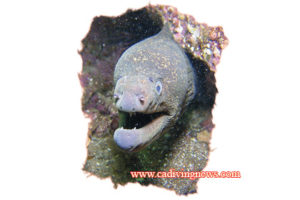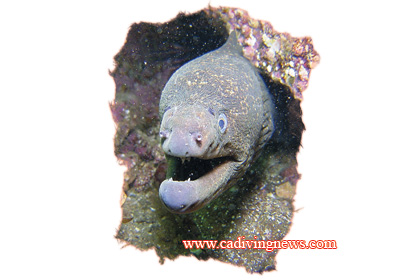 “Blub, blub — oooe‚ — ooooooh, glub!” With the excellent visibility, it was easy to see my dive buddy wildly waving her arms in an excited attempt to get my attention. I’ve seen this many times, and even from afar I can tell it means “excitement” rather than “distress.” I really appreciate when another diver wants to show me something underwater, so I quickly made my way over to her. As I searched the area, looking into a small crevice I noticed what she was so excited about. I was stunned. And very pleased, too. There, in all its glory, was a juvenile California moray eel — the first moray I’ve seen at Anacapa Island in 15 years — and I frequently visit this island.
“Blub, blub — oooe‚ — ooooooh, glub!” With the excellent visibility, it was easy to see my dive buddy wildly waving her arms in an excited attempt to get my attention. I’ve seen this many times, and even from afar I can tell it means “excitement” rather than “distress.” I really appreciate when another diver wants to show me something underwater, so I quickly made my way over to her. As I searched the area, looking into a small crevice I noticed what she was so excited about. I was stunned. And very pleased, too. There, in all its glory, was a juvenile California moray eel — the first moray I’ve seen at Anacapa Island in 15 years — and I frequently visit this island.
About Anacapa
Anacapa Island is one of five islands and two jutting rocks that make up the Channel Islands National Marine Sanctuary, located less than two hours north of Los Angeles. The area is known for its variety of marine life and distinct underwater topography. It is also within easy reach of masses of people living on or near the Southern California coast. Only 12 miles from Channel Islands and Ventura Harbors, four-mile long Anacapa is a popular place. Folks visit on everything from kayaks and jet skis to mega yachts. At least half a dozen large dive charter vessels and a number of smaller boats make half- or full- day trips to select spots around the island.
We were at one of the newer Marine Protected Areas (MPAs) on the north side of Anacapa, commonly called the “front side.” If you’re into fish watching, MPAs are the place to be. Anacapa has one of the oldest MPAs located at Landing Cove established in 1978. It was pretty small but somewhat effective at providing safe haven for sea critters. In 1998, the Channel Islands Marine Resources Restoration Committee requested the Fish and Game Commission to establish a network of MPAs around the northern Channel Islands. In April of 2003 the MPA regulations took effect. Essentially all of the middle and eastern sections on the north side of Anacapa Island are now no-take reserves. In less than a dozen years the changes have been profound. What used to be sea urchin barrens are now healthy kelp stands. In fact, where we saw the moray eel had been devoid of kelp for many years before receiving its protected status. I spent the rest of the dive photographing and just plain enjoying watching the moray.
About Moray Eels
Worldwide, there are some 200 species of moray eels, ranging in size from a mere four inches long to more than 13 feet long. They can weigh up to 50 pounds or more and live 30 years. While morays exceeding 10 feet in length are seen in tropical waters, morays found in California waters only rarely reach lengths of five feet or more. Despite their varying size, all morays are relatively similar in appearance, with an elongated body that tapers and is slightly flattened towards the tail. Morays can be found in a range of colors, including black, brown, gray, yellow, green; many are spotted. It might surprise some divers that moray eels are classified as fish. They don’t appear particularly fishy, but are members of the Muraenidae family. Morays lack gill covers found in other fishes, so they must pump fresh oxygenated water over their gills by opening and closing their mouths like a bellows. This “biting action” makes the sharp-toothed, snakelike moray look menacing, but the fact is, morays aren’t biting — they’re simply breathing. Rather than being the vicious, aggressive attackers out of a Hollywood thriller, morays are actually rather shy creatures that would rather hide from divers than harm them. They’ll usually disappear very quickly if startled. Make no mistake though, if you’re into the habit of blindly jamming your hand into crevices looking for lobsters, and that particular hole happens to be a moray’s home, you could be in for a nasty surprise. Morays have very sharp teeth and can be quite tenacious about not letting go once provoked.
Another thing moray eels lack that other fish species have is scales. Instead, they have thick, smooth skin. They secrete a protective mucus over their skin, which in some species is known to be toxic.
Morays are quite maneuverable and can move backward almost as easily as they can move forward, which allows them to easily move in and out of tight crevices in the rocks. Morays prefer to hunt at night and typically look for octopi and small reef fish. They have a very interesting second set of jaws called pharyngeal jaws; this second set of jaws are located in the throat and can be moved forward to grip prey. Once attached to the prey the jaws can be retracted through the gullet to facilitate swallowing the meal.
While their eyesight is considered mediocre at best, their sense of smell is quite good. Anyone who ever fed morays back in the “old days” can tell you don’t try and hide squid in a pocket or inside your wet suit Feeding any wild animal is potentially hazardous for both you and it. With their poor vision morays often cannot tell where the food ends and the fingers begin.
Not much is known about California moray eel (Gymnothorax mordax) reproduction. Large scale spawning has not been observed in Southern Californian waters. A longstanding theory is that they don’t breed off California because of the colder water temperatures. Marine scientists believe that morays found in our waters have come from mass spawning events off Mexico’s Baja peninsula. To date, no research has been conducted to either prove or disprove this theory.
Often you’ll find several striped red shrimp hanging out with moray eels. This is an example of a symbiotic relationship; the shrimp gets food scraps and protection from the morays, while the shrimp cleans parasites from the morays’ skin. Bluebanded and zebra gobies have also been observed removing parasites from morays. Some tropical morays have been observed engaging in hunting alliances with certain groupers, but no such interspecies cooperation has been documented between California morays and local fish species.
“Please Don’t Pet the Eels”
Many years ago my dive buddy and I “befriended” a moray, off Wood’s Cove in Laguna Beach. We named “him” Wilbur and would always stop at a local market and get him some squid. We interacted with him for many dives and we both would swear he recognized us when we visited. He always took the squid gently and never showed any aggression. Then one day his lair was empty. We kept looking for him for weeks but to no avail. After our latest search we struck up a conversation with the Laguna Beach lifeguard, and he told us that a few weeks back he’d seen a diver with spear gun and large game bag showing a group of folks on the beach the “deadly” eel he had “hunted.” We were devastated, as we knew Wood’s Cove well and had never seen another moray there. Although we can’t be certain, we suspect that our “pet” eel was viewed as dangerous pest by that diver. This is another good reason not to feed wildlife and get them to trust humans.
The California moray is not considered endangered and can readily be found in many areas of Southern California. That said, you just don’t hear as many new “moray” stories. We’re glad to have enjoyed seeing little this one at Anacapa with hope that morays will always be around.
Pharyngeal Jaws of the Moray Eel
The second set of jaws in moray eels, called the pharyngeal jaws, is located in the throat. These jaws are pulled toward prey and grasp it as the oral jaws release. The pharyngeal jaws and muscles move the prey down the throat and into the eel’s stomach. Pharyngeal jaws not only allow morays to feed in tight spaces where body expansion would be impossible, but the second set of jaws allow morays to feed on larger, perhaps more diverse prey.
Source: Illustration by Eo Trueblood, hopkinsmedicine.org
California’s Channel Islands
The Channel Islands lie within a large embayment known as the Southern California Bight — an area just below Point Conception where the California coastline turns sharply to the east. Within this area, the sea floor is comprised of canyons, banks, escarpments, seamounts, and deep basins (the Santa Cruz Basin is deeper than the Grand Canyon). Nutrient-rich waters upwelling from these depths mix and mingle with cool waters from the north (California Current) and warm southern waters (California Countercurrent), creating the Santa Barbara Gyre — a swirling eddy that circulates nutrients and supports a wealth of marine plants and animals, from giant kelp forests and blue whales to tiny crabs and plankton. Here, northern and southern species overlap, creating a transition zone between the Oregonian and Californian marine biogeographic provinces.
The Channel Islands also serve as the meeting ground for sea birds and shore birds that rarely occur together, such as black oystercatchers from the north and American oystercatchers from the south. Both species, as well as hybrids between the two, nest on the islands. Other northern birds, such as pelagic cormorants and pigeon guillemots, overlap with additional southern species, such as Scripps’s murrelets and California brown pelicans.
One nautical mile of water around each island in the park is part of Channel Islands National Park and six nautical miles around each island form the Channel Islands National Marine Sanctuary. Within the park and sanctuary a network of Marine Protected Area (MPAs) provide a refuge for sea life and opportunities for recreation, education, and science. In 11 Marine Reserves, recreational fishing and commercial harvest are prohibited; limited fishing and harvest are allowed in two Marine Conservation Areas. The MPAs total 318 square miles, the largest such network off the continental United States and part of a larger effort throughout the world to conserve natural, historic, and cultural marine resources.
Source: nps.gov
More On MPAs
For more information on marine protected areas, visit oceanservice.noaa.gov/ecosystems/mpa/









